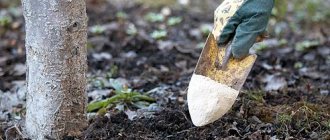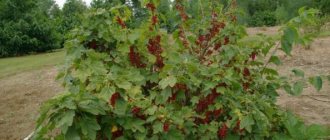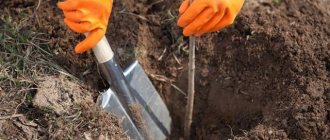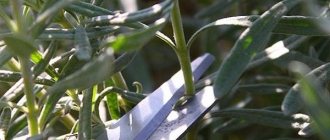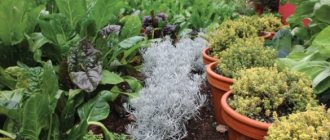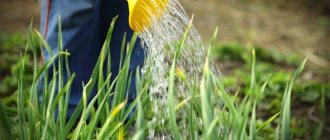The need for a garter
Some varieties of raspberries can do without a garter. Most fruitful varieties bear fruit much better and are less susceptible to disease only thanks to tied bushes.
Why is gartering done in the practice of raspberry cultivation?
- After it, the young shoots are located inside the bush. This greatly facilitates their unhindered growth and development.
- Each flower is pollinated much more efficiently by wind and bees.
- This is an effective protection for two-meter bushes from damage and deformation.
- Time for harvesting is significantly saved. Since it is more convenient to remove berries from tied branches, and injuries from thorns are minimal.
- The volume of fruits after gartering increases significantly, since the shoots receive more sunlight and are illuminated more evenly. The berries form earlier and ripen faster.
- Bushes are less susceptible to attack by pests and diseases.
- Raspberries are protected from strong winds, rain, and snowfall, which can break the bush.
Environmental conditions that affect the fragility and flexibility of raspberry shoots and contribute to their injury and damage:
- significantly increased height of raspberry bushes;
- unexpectedly abundant harvest of berries;
- heavy rains over a long period;
- sharp gusts of strong wind.
Why do you need a garter?
The procedure is suitable for all varieties of crops. The essence of tying is to protect thin shoots of the crop from breaking off due to:
- gusty wind;
- prolonged rains;
- abundant fruiting;
- tall plants: varieties that grow up to 2 m or more especially need tying.
Raspberry bushes
If tying is done correctly, the gardener will receive a lot of benefits. The main advantages are:
- Without this method, small, tasteless berries often ripen: tying provides access to sunlight to the branches, due to which the fruits have the opportunity to fully ripen.
- Organizing growing shoots: prickly bushes take on a well-groomed appearance.
- Protection against fungus and insect pests.
- For bushes growing in the middle of the row, favorable conditions for development are provided. If plants are planted densely and chaotically, then the bushes located in the thicket quickly die off.
- Setting and ripening of a large number of large berries.
- Uniform fruiting: berries receive the same amount of sunlight.
- Convenient, fast, non-traumatic harvesting. This is especially noticeable in the presence of tall bushes with a lot of thorns.
In what cases is it not required?
There are raspberry varieties that are “indifferent” to tying. These include bushes with upright thick stems. You don’t have to tie up black raspberries, the following varieties:
- "Modest";
- "Spirina white";
- "Balm";
- "Coral";
- "Bulgarian Ruby".
Care for these raspberry varieties must be special. Please note the following:
- The first year, do not touch the raspberries, they should develop freely: at the end of the season you will get a hedge.
- In the second year, cut out shoots that extend beyond the 70 cm width of the row.
- Thin out the bushes by cutting out shoots: the distance between the stems is about 20 cm.
Materials used for garter
The best materials for gartering raspberry plantations have always been considered:
- nylon tapes or threads;
- wooden slats 2 m long;
- precast concrete pipes;
- metal posts;
- stakes made of wood or plastic;
- steel bars;
- skeins of twine;
- synthetic fabric strips;
- wire with plastic braid;
- twine made of harsh threads.
There are still a lot of different products suitable for knitting. With proper ingenuity, you can come up with many ways to fasten branches to various supports. It is important that the products used do not injure the skin and the branches of the plant themselves.
fan garter
For a fan garter, you need to drive two-meter stakes between the seedlings. Visually divide each bush into 2 parts, one of which is tied to the right stake, and the second to the adjacent (left).
Thus, part of one bush and part of another are tied to each support, due to which the bushes become like a fan, hence the name of the garter method.
Easy and quick ways for beginners
High productivity of raspberry bushes is observed only when it is tied up correctly and in a timely manner. After all, the skill of a gardener lies not only in acquiring a high-yielding variety. Without observing the technological processes of growing, the bushes, no matter how productive they were before, will quickly wither, the berries will be crushed, and the yield will be significantly reduced.
There are 3 methods of tying raspberry bushes, known for many decades. All of them have proven their viability, increasing the yield of this berry crop. You can choose any of the presented methods, you just need to be safe, avoiding damage to the raspberry branches.
Garter methods:
- bunch or stake method;
- trellis method;
- fan garter.
From time immemorial, the listed methods have been used by all gardeners who successfully grow raspberries. The method is chosen based on the availability of materials and a creative approach to the bush. An equally important role is played by external climatic and weather factors prevailing in a given area. All these methods have proven themselves quite effectively in practice. Combinations of all three methods are often used.
Fan tying
A fairly simple and extremely effective method. Between the raspberry bushes, wooden slats or stakes 2 m long are driven vertically into the ground. The bushes are divided into two parts, one half is tied to the left post, and the second to the right.
When the entire technological process is completed, the raspberry tree becomes like a large fan. Among all the methods, this is considered by gardeners to be the most complex and at the same time the most effective. Because raspberry bushes are evenly illuminated by the sun's rays, and this gives a great advantage.
Trellis garter
Tying raspberries to trellises has proven itself throughout the world as the most universal method of care. It is used by agronomists all over the world, using a variety of means and materials.
In turn, several variants of this method are practiced.
Double garter or pistol
Take a pair of wooden slats 2 m long. Hammer them into the ground at intervals of 4 m. Using soft wire, stretch two parallel guy wires between them - 1 m at the bottom and 1.5 m at the top from the ground. Tie the raspberry branches at two points evenly between the posts and spread them apart. Then secure them at a distance of 0.5 m from each other.
Advantages:
- there will be much more young shoots, this will increase the yield;
- Each branch will receive a sufficient amount of sunlight.
Minuses:
- more difficult to harvest;
- gloves must be used;
- It is possible that branches may break off.
Scandinavian method
Structurally, it is very similar to a pistol, but differs in the height of the garter. The top tension instead of 1.5 m is located at a distance of 2 m from the ground. Below - at a height of 1 m from the ground. Raspberry branches are wound along a stretched wire in an English letter V.
Pros:
- the sprouts receive excellent ventilation;
- When harvesting, convenient access to the fruits is provided;
- ease of inspection to identify diseases and damage to sprouts.
Minuses:
- Damage and defects of branches are possible.
Single method for small gardens
Take 2 columns with supports of 2 m each. Install them at intervals of 3-4 m along the edges of the plantation. Bury to a depth of 0.5 m. Install the remaining posts in the same way. Fasten 2-3 rows of plastic or steel wire on them. The structure must be horizontal.
Tie up shoots that have an ovary separately. The edges of the branches should not be more than 20 cm above the level of the top wire. If they are higher, they must be tied lower.
Advantages: excellent protection from gusts of wind.
Minus: young shoots often break with this method. To prevent this, you need to tie the branches below to plastic wire.
Types of trellis garter
Raspberry trellis garter includes several different garter options.
Attention! The main rule of all options is that the branches should not rise above the top wire. Otherwise, at the first wind, the entire structure will fall to the ground under its own weight, losing the formed and ripened crop.
The following types of trellis garter are distinguished:
- Single is a structure of compact size. With this arrangement, the wire is pulled in 3 positions: 75 cm, 105 cm, 165 cm from the ground level. Each of the shoots is tied independently from the others.
- Double (pistol) - wooden stakes 2 meters high are installed at a distance of 4 meters from each other. A beam is constructed between the pillars in the center of the structure. The wire is fixed parallel to the bottom and top of the central base. The gartering procedure is carried out specifically - the shoot is fixed in 2 places, and then all the branches are spread in different directions, which are attached every 50 cm. The disadvantage of the method is the problems that arise with harvesting.
- Scandinavian is a fairly effective method, but not much different from the double design. The differences between the methods are that the wire in the latter is tensioned at the lower level at a height of 1 meter, and in the second - at 2 meters. The specificity of the process of fixing on a support is the arrangement of the branches in such a way that there are no garters, and the shoot is fixed to the wire like the letter “V”. The advantages of this method are excellent ventilation of tied bushes, the possibility of normal growth of young branches, which subsequently replace old growth. You can pick berries without much effort.
- A mobile turnstile is a modern engineering device. This device allows you to change the position of plants from vertical to horizontal, changing the angle of inclination of the plants and the turnstile by 1200. The method allows all berries located at different levels to receive sufficient lighting. At the same time, the possibility of detecting pests and diseases increases several times.
Thus, the choice of different garter methods allows you to collect the maximum possible yield from the plant. These methods allow you to fully expose the berries to sunlight, saturating them not only with sweetness, but also achieving large sizes.
Video: DIY raspberry trellis
How to carefully, correctly, beautifully tie raspberries?
To properly carry out gartering, you should study all the norms of agricultural technology and the growing season of raspberry bushes. The procedure is best carried out in early spring after trimming excess shoots. Because during this period the buds have not yet begun to bloom. The second possible time for gartering is before the onset of winter, when the process of falling leaves ends.
In late autumn, the garter helps to maximize the protection of the bush from weather conditions that are unfavorable in harsh winters. If the garter is successfully carried out, the bushes will be correctly collected. This will significantly increase the chances of raspberries surviving in the cold season.
Pre-winter tying involves placing the wire at a height of 20 cm from the ground. This will prevent the branches from freezing. They will find themselves much faster under a thick snow cover, which protects all living things from severe frosts.
We bend and tie up the bushes
It is necessary to bend and tie raspberries in the fall in order to use natural thermal insulation material - snow. The timing of bending is important. If the procedure is carried out early, then, due to high average daily temperatures, it is possible to allow interconnected shoots to rot. If you tighten it, the bush will become more fragile closer to frost, it will be difficult to bend it and instead of the necessary bending of the stems to the ground, you can simply break them. The optimal time is considered to be within 10 days after the autumn leaves fall.
As for the height of bending, it is important to bend the raspberries to such a height that in winter the shoots are completely under the snow. For central Russia, this is approximately 40 cm from the ground. At the same time, you should not bend too low. At distances from the ground of less than 20 cm, the bush may become warm from the mulch during thaws. Also, do not try to bend the raspberries in one go, as there is a high probability of damaging some of the branches. Break the operation into several stages. First, tilt the branches, taking into account the pliability of the shoot; as soon as you feel the resistance of the branch, stop, let a day or two pass, and you can repeat the procedure, gradually approaching the range of 20-40 cm we need.
Bend to what? Most often, raspberries are bent and tied to a wire stretched along the rows of the raspberry tree; the wire itself is fixed on clogged pieces of pipe, fittings or wooden pegs. You can also bend the first bush, securing it to a post, attach the second bush to the first bush, and so on along the chain. The garter is carried out with thick nylon threads or strips of synthetic fabric, the main thing is that the threads do not cut the stem and do not rot until spring.
Bent, tied stems should have an arched appearance and be located from the surface of the ground at a distance of no more than 40 cm.
How to plant a remontant variety in the spring with photos
Tying such raspberries has a number of features:
- Brought out 200 years ago, remontant raspberries typically grow as large, strong bushes. It is resistant to wind, rain and bad weather. It would seem that such raspberries do not need supports. However, growing on trellises significantly stimulates its growth and maturation, significantly increasing the yield.
- All branches are evenly illuminated, well ventilated and do not lie on the ground under the weight of ripe berries. For gartering, a two-row trellis 2 m high is used. This design can be made with your own hands. Along each crimson row, pillars are installed at intervals of 3 meters.
- A wire is stretched along them in 2 rows: at a height of 60 cm and 130 cm. As the shoots grow, they are tied up. When growing a double harvest, all branches are divided into 2-year-old ones, which bear fruit in the summer, and young ones, which gradually grow back. They will present a harvest in the fall.
- Single bushes are attached to pegs or formed into a fan. To do this, use a garter to a support that is installed between the rows of raspberries. Fix part of the shoots on one raspberry bush, and then on another.
By regularly tying up his raspberry bushes, every gardener will ensure a high harvest, good crop growth and rapid fruiting. At the same time, we should not forget about observing the timing of the garter and using all the methods listed in our article. And then raspberries will delight you with fragrant, juicy berries, high yield and good quality!
One of the components of the guarantee of high productivity of any crop is competent organization of its care. There are different opinions on the question of when to start preparing raspberries for wintering. In this article, the author tried to systematize all the recommendations and find that “golden mean” that is quite possible to focus on, especially for summer residents who have not yet acquired sufficient practical experience.
Garter methods
In your raspberry garden at the dacha or in the garden of your personal plot, you can use several methods of gartering raspberries. The choice of option depends on the gardener, his desires and capabilities. But when choosing a garter method, you need to pay attention to the fact that it is not only beautiful, but also practical.
We recommend reading
Technology for pruning raspberries in spring and autumn
Rules for caring for raspberries in spring, summer and autumn
Step-by-step instructions for planting raspberries in spring and autumn
When to propagate raspberries by cuttings and suckers
Cola method
In this case, each bush is tied to a single support up to 2 meters high. It is placed very close to or in the center of the plant. No more than 6 shoots with a height of no more than 1.5 m are tied to the support. They are positioned so that they are illuminated as evenly as possible by the sun, the tops of the heads are spread to the sides.
The cola method is one of the simplest and least labor-intensive; the disadvantages are that the berries are not uniform; some of them will contain sourness due to uneven lighting.
Fan method
This option involves tying it to a support, which is installed on 2 sides of the bush. All shoots of the plant are divided into 2 parts and tied to these supports. The fan method is more difficult than the stake method, since it is necessary to correctly divide the branches and place them on supports.
Stages of preparing raspberries for winter
Top dressing
On this point, you should be guided by a simple rule - an increased content of fertilizers in the soil reduces the frost resistance of raspberries. Based on this, it is necessary to carry out the final enrichment of the soil according to a “simplified” program and accurately determine its timing.
Raspberry pruning
In order for the plants in the raspberry garden to develop well next year, each bush should have a maximum of 4 shoots. When planting in rows, their optimal number is no more than 10 per meter of plot. All dried, diseased, broken, as well as those growing sideways and interfering with adjacent bushes are removed clearly, and thoroughly, at the root, preferably level with the ground.
Even the remaining small “stumps,” given that the dried stems are almost hollow inside, are potential sites for the accumulation of various garden pests. They will overwinter there and lay eggs. The end result can be predicted in advance.
How to identify affected stems? Visually, by clearly visible swellings on the trunks.
The same applies to the length of the remaining stems. They should be shortened to approximately 1 m - 80 cm. This is enough for them to begin to grow in the spring, and it will be much easier to cover the raspberry bushes for the winter. But you need to shorten it, making sure to leave the green top. It is she who ensures the process of photosynthesis, and not the lignified raspberry trunk.
Another important point is that not a single leaf should remain on the trunks of the plant. Otherwise, they will begin to rot, and the bud will no longer germinate in this place next year. Cutting off each one individually is a waste of time. It is enough to put on a soft mitten, lightly squeeze your fingers and run your hand along the stem, always from bottom to top. Just be careful not to damage the kidneys.
Attention! All stems and leaves discarded during the pruning process should be burned. Simply storing them on the site, for example, as a supply of “fuel” for a stove, will not lead to anything good. The pests that have settled in them (the same crimson gall midge) will again spread across the territory, survive the winter safely in the ground, and in the spring they will again appear on the plants.
Two-year-old stems are considered to have “expired” their useful life. They are no longer able to bear fruit abundantly or produce large berries. Therefore, they should also be removed without any regret - they will be of no use anyway. It is not difficult to distinguish them from the general mass - by the darker shade of the trunk.
Timing of pruning
Option 1. After the end of the fruiting period. Reasoning - the roots will receive more nutrients, which will help them survive the winter well and subsequently stimulate more intensive development of raspberries.
Option 2. Before the onset of the first cold weather. Rationale - the movement of juices has practically stopped, therefore, no harm will be caused to the raspberries when pruning.
Recommendations
- Experienced gardeners who have been growing this crop for many years advise starting this stage of preparing raspberries for winter no later than the end of September, when the weather is still relatively warm. Yes, there is still juice in the stems, but its circulation is not as intense as in summer. It also gives the trunks some flexibility; This means that when tying and wrapping the bushes there is no risk of damage to the raspberries. But in late autumn, when the stems are already dry, it is quite easy to break them. This is what we should proceed from, taking into account local climatic conditions.
- Double pruning helps increase yield. About the first, its features have already been said. The second is carried out in early spring, with the onset of stable warm days. The point is to shorten the raspberry stems that have survived the winter by about 25 cm. What does this give? The formation of new lateral shoots, which are also capable of bearing fruit. But this is justified if the distance between the bushes is about 65 cm. With a denser planting of raspberries, secondary pruning will only complicate the process of caring for the crop and picking berries.
- If repaired varieties are grown on the site, then it is recommended to completely cut off the entire raspberry bush for the winter.
- For the southern regions, one pruning in spring is sufficient.
Top dressing
Autumn feeding of raspberries is one of the important aspects of successful plant cultivation. If in the summer fertilizers are applied to increase productivity, then, starting in August, feeding means helping the plant recover faster after fruiting, gain strength for a successful winter, and completely complete the process of ripening and lignification of shoots.
How to feed raspberries in the fall
- Under natural conditions, raspberries grow in areas rich in humus, so the best feeding for garden raspberries is rotted manure, compost and chicken droppings. On average, per 1 m2 it is necessary to add 2-3 buckets of manure mixed with two handfuls of ash. Autumn fertilizing with organic fertilizers should be carried out at least once every three years;
- the application of mineral fertilizers also successfully affects the development of the plant, but only potassium-phosphorus fertilizers are used to prepare for winter. Nitrogen fertilizers will lead to active growth of shoots, as a result they will not have time to ripen and the probability of winter freezing of the entire bush increases sharply. As for the quantity, it is enough to add 40 g of granulated superphosphate (dose of double superphosphate 20 g/m2) and 20 g of potassium sulfate per 1 m2 of raspberry to completely cover the plant’s need for potassium-phosphorus fertilizers. It is important to remember that mineral fertilizers must be applied to the depth of the roots, and not scattered on the surface of the earth, therefore such fertilizing is most often accompanied by digging up the earth. In order not to damage the roots, you should dig between rows to a depth of no more than 15 cm, and in rows to a depth of 7-10 cm.
Nitrogen fertilizers are good in the spring, when it is important for raspberries to quickly increase their green mass
How to prepare raspberries for wintering - when to start pruning and how to do it correctly
Gardeners have differing opinions about when to start caring for bushes in the fall. Some believe that it is necessary to cut them right before frost, thus causing minimal harm to the plant - the movement of sap stops at this time, and it would be best to cut off part of the shoots. Others argue that immediately after fruiting it is necessary to remove unnecessary shoots, which will give the rhizome more energy for development.
But most gardeners are sure that pruning should be done in early September, the deadline is early October. The argument is very simple. The fact is that it is at this time that the amount of juice in the stems is still large, but its circulation is much lower than in summer, for example. After pruning, you need to wrap the bushes, tie them and bend them to the ground, and doing this at the end of October and November will simply be impossible due to the high fragility of the stem.
We’ve decided on the deadline, now let’s turn our attention to the pruning process itself. In order for the bush to be properly prepared for winter, we need to remove:
- Old dry shoots. Regardless of how you care for the plant throughout the year, dry shoots cannot be avoided and they will definitely be present in some quantity. We remove them at the root to clean up the thickets a little and allow us to move normally around the plantation.
- Young shoots. Many novice gardeners leave them and make a big mistake. They will freeze anyway, since the stem has no wood, and any frost will be fatal for it. The young shoot only wastes the energy of the bush, that is, useful substances that could be sent to the rhizome and developed. We remove such shoots at the root as early as possible!
- Unnecessary branches in too dense bushes. Please note that the number of shoots affects the weight of one fruit and the more thickets you have in your garden bed, the smaller the berries will be. You need to leave no more than 5-7 shoots on a 3-4-year-old bush - this is the best option if fertilizers will be constantly applied. If there are none, then 5 shoots is the maximum so that the root system has enough strength to provide the entire vegetative mass with a sufficient amount of nutrients.
The branches that you plan to leave for the second year also need to be trimmed a little. If this is a regular raspberry variety (and not a remontant one), then you need to remove approximately 15% of the length of the shoot. As a rule, 15-20 centimeters. This will allow you to remove a section of the plant that is not frost-resistant, which freezes, rots and can lead to the death of the entire branch in the spring. The cut diameter should be at least 6 mm - only a stem of such thickness contains a large amount of nutrients.
Trellis for raspberries made of plastic pipes. Trellis for raspberries: features of using the device
Raspberry is a very flexible plant, so under the weight of the harvest it bends strongly, and the stems of some varieties even lie on the ground. It is for this reason that it is recommended to grow raspberries on trellises. This is especially true in the summer – during fruiting.
The design of the trellises is very simple: on both sides of the row with the plant you need to install supporting horizontal poles (or wire) attached to posts. The raspberry stems are tied to the supports with twine.
The simplest trellis is dug posts, between which wire is stretched and attached in 2 rows
This trellis is easy to make and is known to all gardeners, but its design can be slightly complicated and benefit from it. The support is placed on one side, not at the edge of the row, but at a distance of 30-40 cm from it. All fruiting branches are tilted towards the trellis and fixed. Thanks to this tying, adult stems do not interfere with the growth of young shoots.
Next, we’ll tell you how to tie up raspberries in the spring. The trellis should be installed before the buds open. When the stems are placed at an angle, all the buds grow upward, and the crop is placed on the illuminated side. Growing stems do not mix with two-year-old stems and do not interfere with harvesting. Detaching young shoots from fruiting ones promotes better lighting and ventilation, and also prevents damage to the stems by fungal diseases.
After the last berries are collected, the two-year-old shoots are removed. They are cut down to the very base, leaving no stump. At the same time, you need to remove damaged, thin and short annual stems. It is necessary to leave the strongest, thickest and tallest shoots. The soil under the bushes needs to be loosened. Garden forks are best suited for this; it is important to remove weeds and also water if necessary.
Preparing remontant raspberries for winter - what are the differences?
Many people do not see the difference between ordinary varieties and remontant varieties, but their preparation for winter is extremely different. To be more precise, in the second case it is completely absent. The fact is that remontant varieties have their own peculiarity - they bear fruit not on a two-year-old shoot, but on a fresh, one-year-old one. Thus, the old branches are not needed at all and are cut out at the root. The main task of the gardener when growing remontant raspberries is to develop the rhizome as best as possible so that next year there will be many one-year shoots.
That is, the main emphasis is not on preserving the bush, but on the maximum destruction of the entire vegetative mass, and this must be done immediately when the fruiting period ends. Then all this time it is the root system that will develop. The most acceptable time for removal is mid-October, since the remontant variety bears fruit almost until frost and you can take a little time to enjoy the fruits. If there are a lot of bushes, you can leave a few of them for berries, and cut out the rest so that the root system develops.
Earlier than thought (video - competent pruning of raspberries)
Many people believe that the time to prepare raspberries for winter is in the fall. However, in reality, preparation should begin in the summer. Or rather, at the end of summer. In the last days of the summer season, fertilizers need to be applied to achieve ripening of raspberry wood. The best helpers in this matter are potassium and phosphorus fertilizers, but in no case nitrogen fertilizers. Fertilized soil full of various vitamins is good for any plant, and raspberries are no exception. It is fertilizing, applied in a timely manner, that will give an excellent margin of safety to the root system, which will allow you to count on a rich harvest next year. The last feeding is applied in early October, that is, before the start of the period when severe frosts are possible.
When all the berries have been collected, it’s time to start pruning the bush. The branches that bore fruit this year are pruned. They have served their purpose, are covered with bark, and the plant no longer needs to waste its energy on them next year. But the young green shoots that grew this summer should be left, removing only the weakest and thinnest ones.
Fertilizer for the winter - is it necessary?
Many gardeners, sooner or later, are faced with the choice of whether to fertilize raspberries for the winter or not. Some believe that an excessive amount of nutrients will lead to the circulation of sap and the bushes may freeze, others are confident that it is necessary to develop the root system as strongly as possible, despite the claims of the former. The correct answer is necessary, but only correctly and in a timely manner.
The first lesson to learn is to never apply too much nitrogen fertilizer after August. This can lead to excessive circulation of sap in the stem; it will not “calm down” enough for the winter and may freeze even at a frost of -5 degrees. It is necessary to euthanize the plant as much as possible so that it can withstand extremely low temperatures. “But what about fertilizer in the spring, because the bush needs to start quickly?” -you ask. This is very easy to solve. It is enough to add a little manure and other organic fertilizers before the onset of frost - the process of their decomposition is long, about 4-5 months at least. Just at the moment when the plant begins to come to life, it will receive many useful substances. This concludes the preparation of raspberries for winter and there is no need to invent anything else.
In the spring, if there is a shortage of fertilizer, you can use foliar feeding - the most effective way to give an impetus to development. They act almost instantly, so they are suitable for gaining the vegetative mass of the plant by the time of flowering. But do not overuse these fertilizers; remember, your main task is not lush foliage, but a high yield of berries.
- Author: Maria Sukhorukikh
Rate this article:
- 5
- 4
- 3
- 2
- 1
(0 votes, average: 0 out of 5)
Share with your friends!
Features of raspberry garter in spring and autumn
It is best to carry out the procedure for gartering raspberry bushes in the spring. It stimulates various beneficial processes required for fruits. The following are the benefits of gartering raspberries in the spring months:
- The event helps protect against fungal diseases and various pests hiding in unlit foliage.
- Close placement and density contribute to the crushing of young shoots and their faster death.
- The shoots do not break under unfavorable weather conditions or under the weight of the formed load.
- The fruits are pollinated faster by bees, which provokes faster ripening and the same size of each berry.
- Harvesting is faster and without injury to both humans and shoots.
In the fall, raspberries also need to be tied up, but for a different reason. The peculiarities of forming the correct arrangement of bushes in the months after fruiting increase the chances of surviving the cold winter. This process prepares raspberries for winter and sub-zero temperatures.
As a rule, the essence of the autumn raspberry garter comes down to the fact that for this you need to stretch a wire between the raspberry bushes at a height of 20-25 cm. Before the first frost, you should bend all the branches to the reinforcement and tie them. This way the plant will not freeze when covered with snow. Thus, the garter is carried out in an arched manner, using nylon threads or durable synthetic fabric, which is not capable of rotting ahead of time.
Important! But it is not necessary to use the fan (arc) method of gartering for the winter; you can tie up raspberry bushes in any way you like. But this garter in this way is best suited for further covering the bushes, which is definitely necessary if you have harsh winters.
Video: how to tie raspberries for the winter
Attention! The procedure of bending to the ground should be started in time. If this process is delayed until the first frost, the plant will lose flexibility, become brittle and may break under any influence.
Thus, gartering raspberries at certain periods is important and necessary in its own way. Therefore, it is recommended not to neglect either the autumn or spring garter.
How to tie raspberries pictures. Trellis for raspberries: types, manufacture and application
A raspberry trellis is used for gartering it, which is necessary for healthy growth of bushes and a good harvest of berries. When ripening, the berries create a large load on the branches of the bush, which can lead to their breakage and, as a result, spoilage of the fruit. A reliable supporting structure makes it easier to care for raspberries and reduces the likelihood of damage to the bush. We will consider the types, production and use of trellises in more detail in this article.
Features of using the design
A trellis is a supporting structure that is used in gardening for tying up shrubs and grapes. Most raspberry varieties have a large height (up to 1.8 meters) and thin branches that bend easily from the overall weight of the fruit or wind. Bushes may break or sink all the way to the ground, exposing the fruit to dirt and moisture, causing the berries to rot or spoil. The use of support structures for gartering bushes has a number of advantages:
- the berries do not come into contact with the soil and always remain clean, even after rain;
- tying the bushes ensures rapid and uniform ripening of the berries;
- the branches of the bush are well ventilated, so excess moisture does not remain on them, which reduces the likelihood of the appearance and spread of fungus;
It is more convenient to care for tied bushes; harvesting is also much easier, since there is no need to lift bent branches and look for unspoiled berries on them.
Why is it necessary to tie up raspberries?
Obtaining high yields of raspberry bushes is possible only if the peculiarities of planting care are observed. Tying up bushes is a must-have maintenance process to achieve excellent results. Neglecting this procedure will lead to seasonal harvesting of small-sized and tasteless berries. Therefore, before tying up raspberries, you should familiarize yourself with the technical features of correctly carrying out this gardening event.
In some cases, it is not necessary to garter raspberries in order to achieve a bountiful harvest. For a number of varieties, gartering is not a mandatory garden activity. However, most varieties of yellow and common raspberries need to be tied up.
Raspberries on a trellis
This is due to the fragility and flexibility of their shoots, which break under a number of conditions:
- strong gusty wind;
- prolonged rainfall;
- abundant fruiting;
- too tall bush.
Important! If you tie up raspberry bushes, the harvesting procedure at the end of summer becomes easier - the prickly shoots that grow in different directions are arranged in an orderly manner.
However, the primary reason for tying up raspberry bushes is to increase the yield, since in order for the fruits to be sweet and large, abundant lighting is necessary.
Note. Raspberry gartering in the spring is carried out before the buds begin to bloom on the shoots. Gartering of bushes at the end of the autumn season is carried out to ensure the safety of the plant in the face of winter.
As a plant, the raspberry bush is considered an unpretentious garden planting. But, if you do not carry out the necessary care measures, which include tying, the bush planting will become overgrown with young shoots and go wild.
The advantages of the raspberry garter process are:
- protection against fungal diseases;
- prevention of insects;
- improving germination conditions for central shoots;
Important! When planted in dense rows, plantings that find themselves in the thicket are subject to rapid death.
- a ripe harvest of large berries does not contribute to the breakage of the bush;
- unfavorable weather conditions do not affect the safety of the stems;
- setting and ripening of raspberries occurs quite quickly;
- uniform fruit ripening;
- facilitating the harvesting process.
Maturation stage
Interesting. Compliance with all the conditions for proper raspberry garter will help achieve excellent yield results.
How to protect raspberries from frost
Raspberries require shelter for the winter only in cold regions. Of course, if you grow raspberries or blackberries, then keep in mind that they are more heat-loving and tender, so in order to avoid freezing, it is better to wrap them before frost.
Start building shelters only when frost reaches 10-15 degrees. Previously, there was no need to insulate berry plantings - raspberries can be banned.
In regions where snow falls heavily in winter, it is enough to simply bend the raspberry stems to the ground, tying them into bunches. Over time, snow falls on them and under such a blanket the bushes will overwinter well.
If the region is windy and there is little winter precipitation, then the bunches of stems can be wrapped with any covering material, bent to the ground, pinned with staples, and topped with spruce branches or branches of fruit trees left after autumn pruning. They will serve as a kind of snow retention screen; snow will accumulate between the branches and the raspberry tree will not freeze under this “blanket”.
Our store offers a large selection of raspberries: yellow, red, orange and even purple are in stock.
Varieties for every taste - remontant or regular, with a single fruiting. Experts recommend periodically updating your berry plantings, and then your garden will have a lot of sweet and fragrant berries that both adults and children love. Author of the article: Oksana Artemenko
Raspberry shelter and snow retention
The plant can be covered with a 20-centimeter layer of straw or spandex (agrofibre): it allows air to pass through and protects the raspberry from the cold. This is true when there is little precipitation and in regions with particularly cold winters such as the Urals and Siberia, where in addition to shelter, raspberries are additionally covered with snow.
Hilling raspberries with snow
Pruning raspberries before winter
In the fall, it is recommended to do sanitary pruning of raspberries. Over the winter, many shoots may freeze or dry out under cover, so now it is best not to cut them radically. We recommend removing diseased or dried out stems, as well as any branches that bear fruit. They have already exhausted their resource; there will be no more berries for them. It is better to leave everything else until spring, so that after the snow melts, you can evaluate the quality of the bushes that have emerged from winter and remove excess shoots.
Raspberries: planting and caring for bushes of a fruitful plant
Raspberries are an unpretentious crop whose fruits have a pleasant taste and antipyretic properties. The jam made from this berry is very tasty and aromatic. Dense raspberries look beautiful in any area. Raspberries can be planted in spring or autumn. Growing raspberries in the country is not as complicated as it seems. If everything is done correctly, the bushes will quickly take root, begin to grow intensively and produce a rich harvest. From this publication you will learn how to tie raspberries to a trellis.
Description and characteristics of Pineapple variety strawberries, planting and care
Raspberries belong to the Rose family. It is usually an upright shrub with small thorns. The flower of the plant is small. The fruits come in different shades - from light pink to almost black (in the case of blackberry raspberry varieties). Raspberries are yellow in color.
The branches on which the fruits will grow appear in the second year of the plant’s life. In the southern regions of Russia, fruits can appear already in the first year of planting raspberries. Currently, breeders have developed remontant raspberry varieties that are capable of producing crops at lower ambient temperatures.
Features, methods and schemes for planting raspberries, fertilizer for the plant
Raspberries should be planted on neutral or slightly acidic soils. It is better to choose a place for the bush that is sunny, protected from strong winds, and has good snow cover in the winter. You also need to ensure that the predecessors of raspberries are not plants that are prone to the same diseases, for example, tomatoes, strawberries, potatoes.
The optimal time for planting raspberries is spring and autumn; green cuttings are planted in summer. It is necessary to prepare the soil for planting in advance, in the case of autumn planting - a month in advance. In spring, this can be done immediately 2-3 weeks before placing the plant in the ground.
Before planting, the future raspberry tree must be fenced with slate, digging it to a depth of about 35-40 cm. This must be done so that the raspberry root system does not spread to other beds and areas. The distance from the raspberry bush to the fence must be at least 1 m. There are several ways to grow the plant:
- in separate bushes - about 10 branches are left on the bush and planted in separate holes;
- trellis or tape method - plants are planted in one row in trenches.
To plant individual bushes, you need to make holes approximately 40 x 50 cm in size. You need to pour a small mound of the planting mixture into each hole. Before planting, it is recommended to moisten the roots of the plant in a nutrient solution of mullein or a special solution of planting mixture. Then they lower the raspberries into the hole and sprinkle the roots of the plant with a fertile layer of soil.
It is necessary that the distance between the bushes be about 1 m, and between the rows - about 2 m. The neck of the root should protrude several centimeters above the soil, so that after complete shrinkage of the soil and watering it will be at ground level. The roots of the plant should not be lowered too deeply, as this can lead to rotting of the root bud. A high planting is also undesirable for raspberries.
In the case of trench planting of bushes, it is necessary to dig a trench about 45 cm deep and about 50 cm wide. The number of trenches depends on the number of intended rows of raspberries. The optimal distance between rows is about 1 m, the gap between plants is approximately 40 cm.
You need to fill the trench with a nutritious planting mixture. It includes:
- rotted manure or compost;
- fertile topsoil;
- mineral fertilizers - double superphosphate is best.
All components are added to the trench in layers or a mixture is made by mixing the components.
After planting, the seedlings must be watered and then mulched with humus, peat or regular dry soil. If the soil is well moistened by precipitation, then additional watering is not required. Provided that the buds of the plant are well developed, they need to be trimmed, leaving 30 cm.
Helpful advice! Nitrogen-containing fertilizers are not recommended to be added during planting. Raspberries will not take root well. It's better to add a little ash.
How to properly tie up raspberries: tips on care, watering and pruning
Raspberries need to be watered well, but in moderation so as not to flood the roots. The plant especially needs sufficient saturation with liquid in the spring and summer.
Pruning for raspberries is needed to shorten fruiting shoots and remove too thick and unnecessary shoots at the roots. Usually, in the spring after planting, fruit-bearing branches are pruned by about 20 cm. From the second year of life, the stems of the plant are shortened annually after harvest or in the spring. After the winter period, the branches are cut off by about 10 cm to a strong bud.
In order not to frequently dig up the soil, the row spacing can be mulched - covered with straw or peat. To prevent frost damage to raspberries, many varieties need to be bent down. To do this, you need to tilt the bushes towards each other and tie them.
To prevent the bushes from breaking under the weight of the fruit, they need to be tied up. The most commonly used method is the fan method. In this case, you will need to drive two sticks between the bushes - and raspberries are tied to them at different heights: part of the shoots of one bush and part of the stems of the neighboring one. The result will be a kind of fan.
In the case of the trench planting method, the best option would be to use a trellis garter. You will learn more about how to make a trellis for raspberries later in this article.


